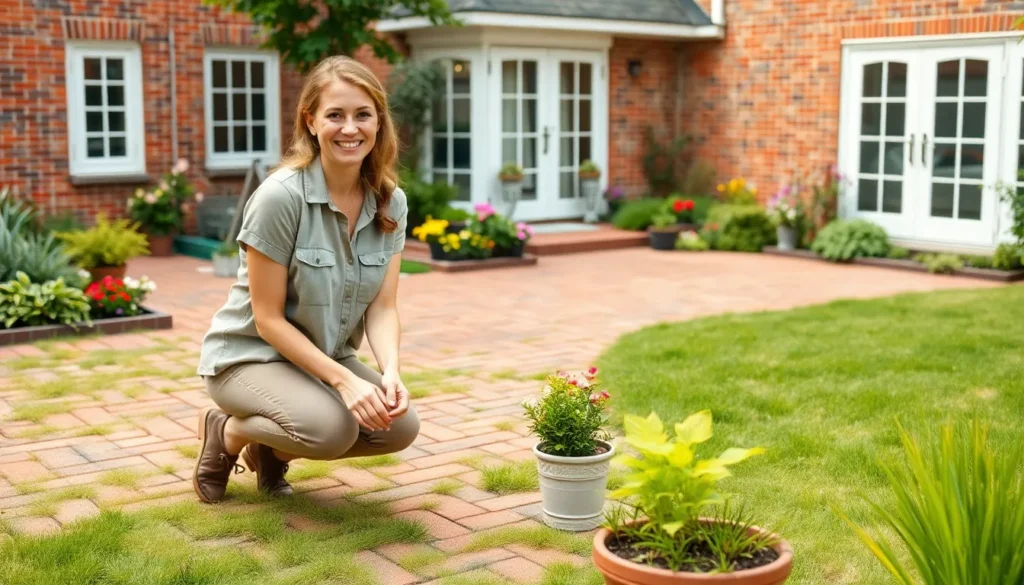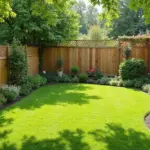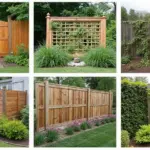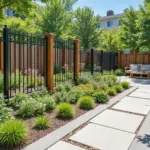We’ve all dreamed of transforming our backyards into stunning outdoor retreats where we can relax and entertain. Brick patios offer the perfect solution – they’re timeless, durable, and incredibly versatile for any industry design. Whether you’re working with a compact urban space or sprawling suburban yard, brick creates that warm, inviting atmosphere we all crave.
From classic herringbone patterns to modern geometric layouts, brick patios can complement any architectural style while adding serious value to your property. We love how brick weathers beautifully over time, developing character that synthetic materials simply can’t match.
The best part? Brick patio installation is more accessible than you might think. With countless design possibilities and proven longevity, it’s no wonder homeowners consistently choose brick for their outdoor living spaces. Let’s explore the most inspiring brick patio ideas that’ll transform your backyard into the outdoor oasis you’ve always wanted.
Classic Red Brick Herringbone Pattern Patios
Red brick herringbone patterns create stunning visual interest while maintaining the classic charm that makes brick patios so appealing. We’ll explore how this traditional design elevates your backyard space through timeless sophistication.
Traditional Herringbone Layout Benefits
Herringbone patterns offer exceptional structural stability by distributing weight evenly across interlocking brick surfaces. We find this design particularly effective for high traffic areas since the angled brick placement prevents individual pieces from shifting or settling unevenly over time.
Visual appeal increases dramatically with herringbone layouts as the zigzag pattern creates ever-changing texture and movement. Your patio gains sophisticated depth that complements both traditional Colonial homes and contemporary architectural styles.
Versatility shines through herringbone designs since you can orient the pattern in multiple directions. We recommend running the pattern parallel to your home’s longest wall to create an elongated appearance or perpendicular to add width to narrow spaces.
Durability improves significantly with herringbone installations compared to running bond patterns. The interlocking structure prevents individual bricks from loosening while providing superior resistance to freeze thaw cycles common in northern climates.
Installation Tips for Herringbone Designs
Base preparation requires extra attention for herringbone patterns since the angled brick placement demands perfectly level surfaces. We suggest creating a 4 inch compacted gravel base topped with 2 inches of sand for optimal stability.
Layout planning becomes crucial with herringbone designs to minimize cutting and waste. Start from the center of your patio space and work outward to ensure balanced pattern placement along all edges.
Cutting techniques for herringbone patterns require precision since border bricks need exact angles to maintain pattern integrity. We recommend using a wet saw with diamond blade for clean cuts that fit seamlessly against edges and obstacles.
Joint spacing should remain consistent at 1/8 inch between bricks to preserve the herringbone pattern’s visual flow. Use spacers during installation to maintain uniform gaps throughout the entire patio surface.
Maintenance Requirements for Red Brick
Cleaning frequency for red brick patios should occur seasonally to prevent moss growth and staining. We recommend power washing annually at 1500 PSI to remove accumulated dirt without damaging brick surfaces or mortar joints.
Sealing applications help preserve red brick color while protecting against water penetration and freeze damage. Apply penetrating sealers every 2 to 3 years for optimal protection in harsh weather climates.
Joint maintenance requires regular inspection and repointing when mortar becomes cracked or loose. We suggest using matching mortar color to maintain the patio’s original appearance while ensuring structural integrity.
Weed prevention becomes essential in brick patio joints where organic material can accumulate. Apply pre emergent herbicides in early spring and use polymeric sand between joints to discourage weed growth throughout the growing season.
Modern Geometric Brick Patio Designs
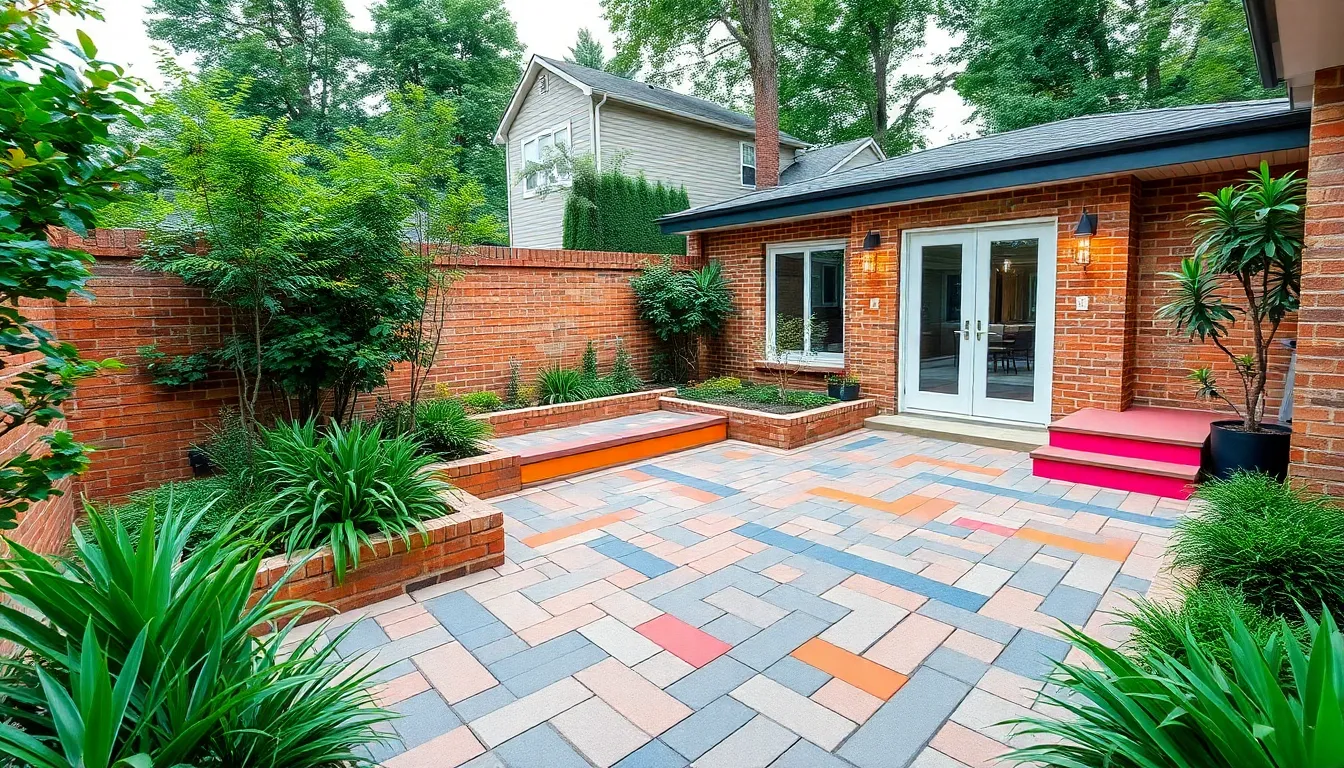
Modern geometric brick patios embrace clean lines and architectural precision to create sophisticated outdoor spaces that complement contemporary home designs. These innovative layouts move beyond traditional patterns to incorporate squares, rectangles, circles, and curves that add distinctive elegance to any backyard retreat.
Contemporary Square and Rectangular Patterns
Contemporary square and rectangular brick patterns deliver the sleek, orderly aesthetic that modern homeowners crave. Modular paver patterns using these uniform shapes provide exceptional flexibility and structural stability, particularly in regions experiencing freeze-thaw cycles. Clean lines create crisp visual boundaries that make outdoor spaces feel more organized and intentional.
Popular contemporary patterns include herringbone, basket weave, and running bond arrangements that add texture and depth while maintaining neat visual appeal. These layouts work exceptionally well for entertaining areas since they create defined zones without overwhelming the space with busy designs. Square and rectangular bricks also allow for easier installation and maintenance compared to more complex geometric shapes.
Mixed Brick Size Arrangements
Mixed brick size arrangements create compelling visual contrast that elevates patio designs beyond simple uniformity. Different sized brick pavers arranged intentionally enable creative pattern combinations customized to your exact aesthetic preferences. Large format bricks paired with smaller accent pieces can define walkways, create borders, or establish focal points within the overall design.
This technique works particularly well in geometric patios where varying sizes can emphasize exact areas or create rhythm throughout the space. Combining standard bricks with oversized pavers adds architectural interest while maintaining the structural integrity needed for high traffic areas. Strategic placement of different sized elements guides the eye naturally through your outdoor living space.
Color Blocking Techniques
Color blocking with bricks of different hues arranged in distinct patterns adds personality and vibrancy to modern patio designs. This trendy technique highlights exact areas or creates dramatic focal points within your patio layout. Pairing traditional red bricks with muted grays or contrasting charcoal shades makes designs stand out while complementing surrounding landscaping elements.
Accent borders using contrasting brick colors provide finishing touches that refine your patio’s overall appearance. Color blocking works especially well when combined with mixed material approaches, such as incorporating gravel sections or concrete pavers that create striking textural variety. Strategic color placement can also help define different functional zones within larger patio spaces, such as dining areas versus lounging sections.
Curved and Circular Brick Patio Layouts

Moving beyond angular designs, curved and circular brick patios introduce an elegant softness that transforms rigid outdoor spaces into flowing retreats. These organic layouts eliminate sharp corners and create inviting environments that blend seamlessly with natural surroundings.
Creating Flowing Organic Shapes
Curved edges revolutionize how we approach patio design by fitting naturally into irregular or restricted backyard spaces. Smooth transitions between patio and lawn eliminate abrupt boundaries that can make outdoor areas feel choppy or disconnected.
Organic shapes encourage relaxation through their natural flow, creating a more welcoming atmosphere than traditional rectangular layouts. These designs complement asymmetrical yard configurations and work exceptionally well alongside curved pool edges or winding garden paths.
Visual flow improves dramatically when we incorporate gentle curves that guide the eye naturally through the space. Curved brick patios enhance the overall industry by creating harmony between hardscape and softscape elements, making backyards feel larger and more cohesive.
Incorporating Fire Pit Centers
Fire pits serve as natural anchors in circular and curved brick patio designs, creating focal points that draw people together for conversation and warmth. Central positioning maximizes both space utilization and social interaction opportunities.
Circular patios accommodate fire pits perfectly because the round shape encourages equal access from all seating positions around the perimeter. A 20-foot diameter patio provides approximately 314 square feet of space with a 62.8-foot perimeter, offering ample room for seating arrangements that face the central fire feature.
Harmony emerges naturally when fire pit placement follows the patio’s curved lines, creating a cohesive design that feels intentional rather than added as an afterthought. This integration makes the fire pit feel like an essential part of the overall layout rather than a separate element.
Border Design Options
Contrasting brick patterns define curved patio edges while maintaining the flowing aesthetic that makes these designs so appealing. Different colored pavers or varied textures create visual boundaries without disrupting the organic feel.
Border flexibility allows for creative variations such as scalloped or tiered edging that adds visual interest while following the main curve. These subtle modifications prevent borders from becoming monotonous while preserving the overall design flow.
Edge definition becomes an art form when we use borders that complement rather than compete with the curved layout. Borders can follow curves exactly or introduce gentle variations that enhance the patio’s natural character and integrate beautifully with surrounding industry elements.
Multi-Level Brick Patio Structures

We can transform flat outdoor spaces into ever-changing landscapes by incorporating multiple tiers and elevation changes. These sophisticated designs create distinct functional zones while maximizing both visual appeal and practical usability.
Raised Platform Benefits
Raised brick platforms elevate your outdoor dining and seating areas to create commanding views of the surrounding industry. This elevation naturally improves sight lines throughout the yard while establishing a sense of privacy and enclosure that distinguishes the platform from other garden areas.
Better drainage becomes an immediate advantage since raised platforms allow water to flow away from seating areas more effectively. We can hide utilities and structural elements beneath these elevated surfaces, creating cleaner lines and unobstructed spaces above.
Uneven landscapes become manageable opportunities rather than obstacles when we incorporate raised platforms. These structures adapt perfectly to sloped terrain and can be combined with stairs or retaining walls to create seamless transitions between different yard elevations.
Privacy increases naturally as raised platforms create physical separation from ground level activities. The elevated position provides a sense of enclosure while maintaining open views of desired industry features.
Step Integration Methods
Brick steps connect multiple patio levels safely while adding decorative elements that enhance the overall design. We can build steps using matching bricks for seamless integration or choose contrasting materials to create striking visual accents.
Straight staircases work best in formal designs and limited spaces where efficiency matters most. Curved steps add elegance and soften the transition between levels, while L-shaped configurations maximize corner utilization and create natural landing areas.
Lighting integration becomes essential for both safety and ambiance in multi-level designs. We can incorporate LED strips along step edges or install fixtures within the brick structure itself to illuminate pathways after dark.
Non-slip textures ensure functionality and comfort regardless of weather conditions. Using bricks with proper riser heights and adequate tread depth creates safe navigation while maintaining the aesthetic appeal of the overall design.
Retaining Wall Combinations
Retaining walls serve dual purposes by providing structural support while improving the visual appeal of multi-level brick patios. These walls hold back soil on sloped yards to create stable, level surfaces for outdoor activities.
Seating opportunities emerge naturally when we design retaining walls at appropriate heights for comfortable sitting. This dual functionality maximizes space utilization while reducing the need for additional outdoor furniture.
Material coordination becomes important when combining retaining walls with patio surfaces. We can use matching bricks or complementary stone veneer to create cohesive designs that blend seamlessly with the main patio area.
Built-in features like fire pits, water elements, or planting beds can be incorporated directly into retaining wall designs. These integrated amenities create focal points while maintaining the structural integrity of the wall system.
Creative space shaping becomes possible when we combine retaining walls with multi-level patios. This approach allows us to work with natural terrain while creating defined outdoor rooms that support various activities and enhance overall backyard functionality.
Brick Patio Color Variations and Combinations
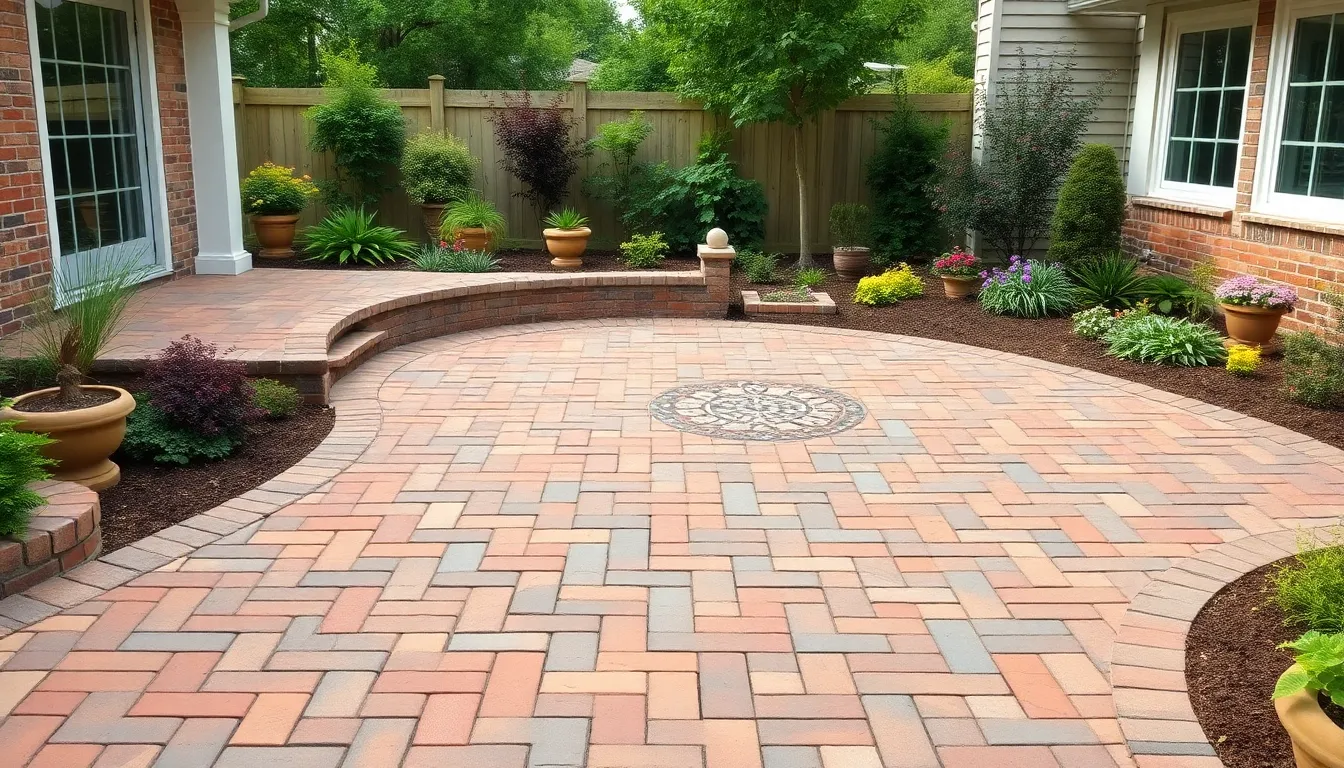
Brick patios offer exceptional versatility through color choices that range from classic red and earthy tones to sophisticated grays, tans, and even painted or stained options. Combining different brick colors creates striking visual effects while helping define exact functional areas within your outdoor space.
Weathered and Aged Brick Options
Weathered brick patios bring timeless rustic charm to backyard spaces through their natural texture variations and uneven surfaces. These aged materials create a vintage aesthetic that perfectly complements lush greenery and mature trees in your outdoor retreat. We recommend pairing weathered bricks with subtle stone tiles or other natural materials to break up the space and add sophisticated visual interest. Historic appeal emerges naturally when weathered bricks develop unique character over time, making each patio installation truly one of a kind.
Two-Tone Design Strategies
Two-tone brick combinations involve using distinct colors to create patterns while separating functional zones throughout your patio area. Popular approaches include featuring one brick color in herringbone or running bond patterns for the main space, then adding contrasting border colors to outline edges and pathways. Visual interest increases dramatically when warm reds mix with muted grays or when lighter tans soften the overall appearance. Gray bricks arranged in running bond patterns offer modern warmth that works exceptionally well for dining areas and seating spaces.
Accent Border Possibilities
Accent borders provide the finishing touch that transforms ordinary brick patios into polished outdoor masterpieces. Border designs can feature different brick colors, contrasting patterns, or complementary stone tiles that frame your patio while visually anchoring furniture arrangements. Common border patterns include soldier courses where bricks stand vertically, basket weave accents, or simple linear edges in darker or lighter brick tones. Practical benefits emerge as these borders help delineate garden beds adjacent to your patio while creating elegant visual transitions between different outdoor zones.
Integration With Existing Landscape Features
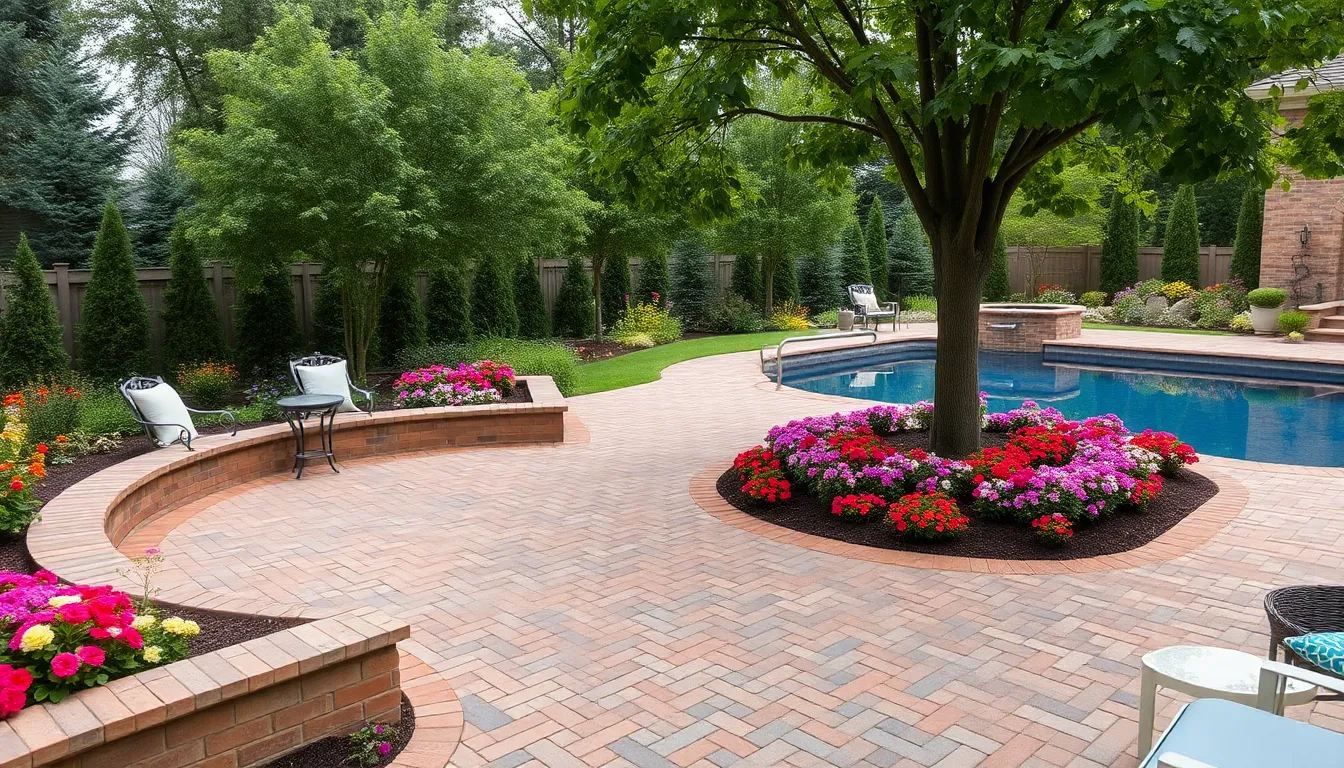
Working with your existing industry features creates a cohesive outdoor environment where your brick patio feels like a natural extension of your backyard. Strategic integration ensures every element complements the others while maximizing functionality.
Connecting to Garden Beds
Curving your brick patio layout around existing planting areas creates smooth transitions that make the hardscape feel like an organic garden extension. Plants naturally soften the patio edges, visually blending hardscape and softscape elements for a harmonious look. Selecting complementary brick colors that coordinate with your garden palette enhances the overall cohesiveness of the space.
Building flower beds directly adjacent to your patio perimeter brings vibrant colors and textures closer to your entertaining area. We recommend adding potted plants around the patio edges to create flexible seasonal displays that can change throughout the year. Extending planting beds into the patio space using strategic cutouts allows you to incorporate favorite garden specimens without sacrificing paved entertaining space.
Incorporating Existing Trees
Creating circular or organic shaped cutouts in your brick patio design preserves mature trees while allowing the pavement to flow naturally around them. Trees become stunning natural focal points that provide valuable shade and create intimate gathering spots within your patio space. Adding contrasting brick borders or square stone tile accents around tree openings defines these special areas with elegant detail.
Surrounding tree bases with complementary greenery and soft landscaping maintains the lush garden feel even within large paved areas. We suggest installing built in seating around tree cutouts to maximize the functional benefits of these natural shade providers. Selecting slip resistant brick patterns like herringbone or running bond near tree areas ensures safety where fallen leaves might create slippery conditions.
Blending With Pool Areas
Choosing slip resistant brick surfaces and moisture tolerant installation methods ensures your patio performs beautifully in pool environments. Popular patterns like running bond and herringbone provide excellent traction while adding visual interest and structural durability around water features. Installing brick transition strips between your patio and pool deck creates seamless connections that unify both hardscape elements.
Incorporating poolside seating areas, planters, and pergola structures transforms basic pool decks into complete outdoor living environments. We recommend combining bricks with complementary materials like limestone countertops and Belgard pavers to create sophisticated outdoor kitchens near pool areas. Adding fire pit zones within your brick patio design extends the swimming season and creates year round entertainment possibilities.
Budget-Friendly DIY Brick Patio Ideas
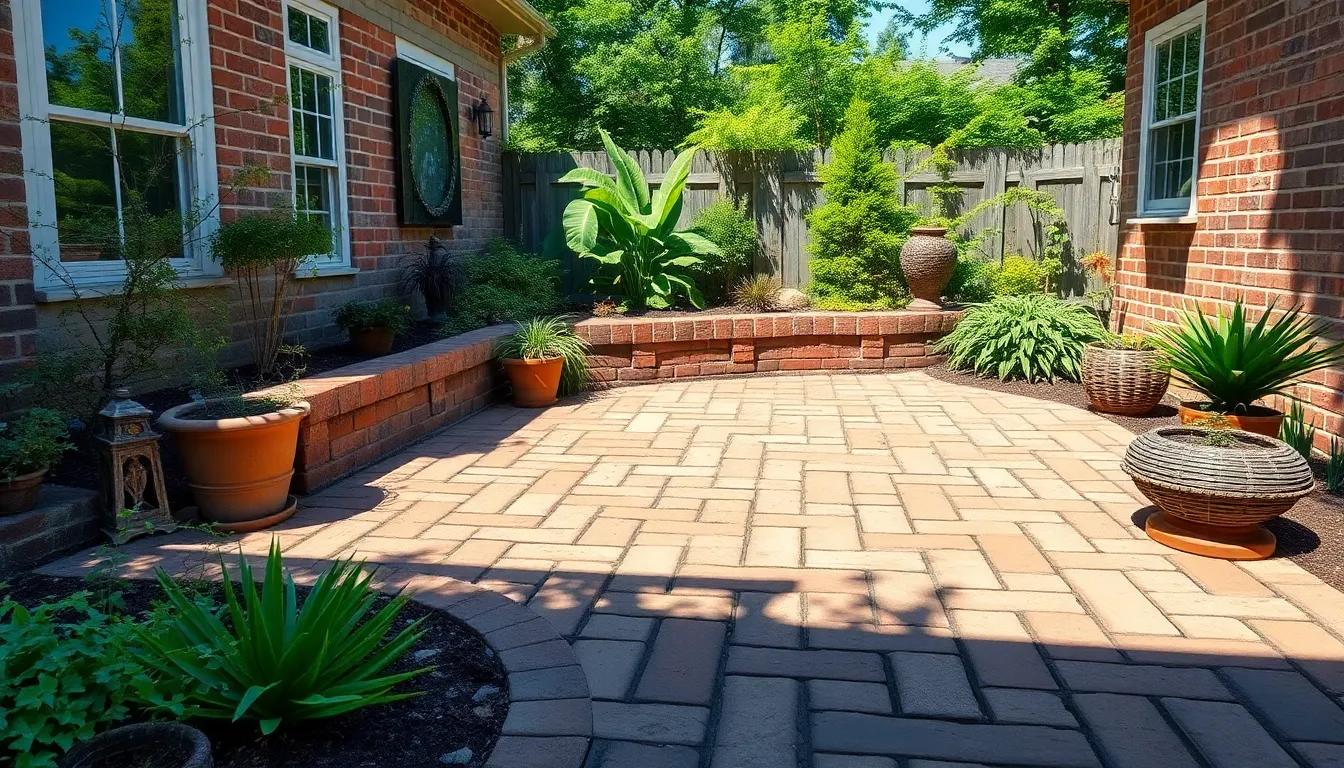
Building a stunning brick patio doesn’t require breaking the budget or hiring expensive contractors. We’ll explore smart approaches that let you create beautiful outdoor spaces while keeping costs manageable.
Reclaimed Brick Options
Reclaimed bricks offer an affordable pathway to achieving that coveted rustic charm in your backyard retreat. Salvage yards become treasure troves where we can discover unique bricks with rich histories and character that new materials simply can’t match. Classified ads frequently list homeowners selling leftover bricks from renovation projects at significantly reduced prices.
Demolition sites present another opportunity to acquire quality materials, though we recommend checking with site managers first. These weathered bricks display natural color variations that develop over decades, creating visual interest without additional cost. Cleaning becomes the primary task, but this simple process reveals hidden beauty beneath surface dirt and old mortar.
The cost savings prove substantial when compared to new brick prices, often reaching 50-70% less than retail alternatives. Character marks, slight imperfections, and patina variations make each reclaimed brick unique, contributing to an authentic vintage aesthetic that perfectly complements traditional and modern designs alike.
Simple Installation Patterns
Running bond patterns provide the easiest entry point for first-time DIY enthusiasts tackling brick patio projects. This straightforward layout requires minimal cutting and creates clean lines that work beautifully in both small and large spaces. Stack bond arrangements offer another beginner-friendly option, featuring bricks aligned in perfect rows that emphasize geometric precision.
Basketweave patterns combine simplicity with visual appeal, alternating brick orientations to create texture without complex calculations. The sandset method emerges as our recommended installation approach for DIY projects, starting with proper excavation of the designated area. Gravel installation follows, providing essential drainage and a stable foundation for the entire structure.
Industry fabric placement prevents weed growth while allowing water drainage, followed by sand leveling that creates the perfect bed for brick placement. Polymeric sand swept between joints locks everything in place, eliminating the need for mortar and making future adjustments possible if needed.
Cost-Saving Design Tips
Limiting patio size to actual needs prevents unnecessary material expenses while maintaining functionality for your exact requirements. Local materials reduce transportation costs and often complement regional architectural styles better than imported alternatives. DIY installation eliminates labor expenses entirely, with a 100 square foot patio achievable for approximately $200 using basic materials and personal effort.
Proper grading becomes essential for long-term success, requiring at least 1/4 inch slope per linear foot away from house structures. This drainage consideration prevents foundation issues and eliminates costly repairs down the road. Stakes and mason’s line help mark patio edges before excavation begins, ensuring level lines and correct pitch throughout the project.
Pattern selection impacts material waste significantly, with simpler designs requiring fewer cuts and reducing brick waste. Border edging using contrasting materials or strategic plantings enhances visual appeal without major cost increases. These finishing touches create professional appearances that rival expensive installations while maintaining budget-conscious approaches to outdoor living enhancement.
Maintenance and Longevity Considerations
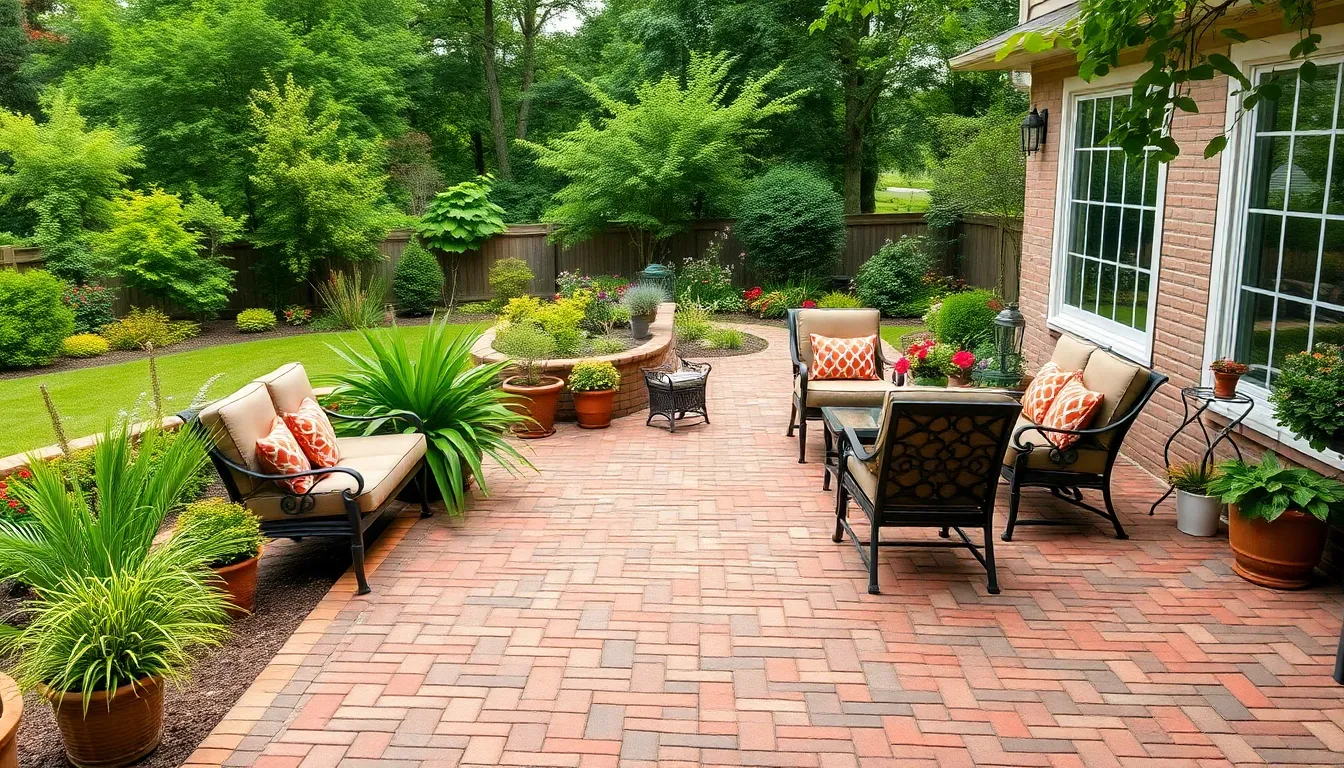
Regular maintenance ensures your brick patio investment provides decades of beauty and functionality. Proper care preserves both the structural integrity and aesthetic appeal that makes brick patios such valuable additions to outdoor spaces.
Sealing and Protection Methods
Sealing your brick patio surface protects against moisture, stains, and fading caused by outdoor elements. Professional sealant application helps prevent mold and mildew growth while maintaining the rich color and texture of your bricks.
Resealing frequency typically requires attention every summer or as wear patterns dictate. Weather exposure and foot traffic determine how often your patio needs fresh protection, with high use areas requiring more frequent applications.
Professional installation delivers optimal results for sealing projects. Expert contractors understand proper application techniques that ensure maximum longevity and protection for your brick investment.
Weed Prevention Strategies
Manual weed removal involves pulling unwanted growth from cracks by their roots to prevent regrowth. Regular inspection and immediate removal keeps small problems from becoming major maintenance issues.
Chemical weed killers provide effective control, while polymeric sand offers an eco friendly alternative for filling gaps between bricks. This hardening sand reduces available space for weeds to sprout and establishes a more stable surface.
Regular debris removal prevents organic buildup that encourages weed and moss growth. Sweeping away leaves and accumulated materials every 1 to 2 weeks maintains a clean surface that discourages unwanted vegetation.
Long-Term Care Requirements
Routine upkeep combines consistent cleaning, weed control, and sealing to preserve your patio’s surface and structural integrity. Creating a maintenance schedule that includes sweeping, washing, inspection, and sealing phases extends your patio’s lifespan significantly.
Seasonal repairs address cracks, chips, or drainage problems before they worsen into costly damage. Spring and fall deep cleaning sessions provide opportunities to assess your patio’s condition and plan necessary improvements.
Furniture management during maintenance allows access to the entire patio area while protecting your outdoor pieces from cleaning products. Temporarily relocating items ensures thorough care and prevents accidental damage during upkeep activities.
Value preservation through consistent maintenance enhances your property’s worth while providing durable, enjoyable outdoor living spaces for years to come.
Conclusion
We’ve explored countless ways to transform your backyard with stunning brick patio designs that suit every style and budget. From traditional herringbone patterns to modern geometric layouts and flowing curved designs brick offers unmatched versatility for creating your perfect outdoor retreat.
Whether you’re planning a DIY weekend project or envisioning a multi-level entertainment space these ideas prove that brick patios remain one of the smartest investments for your home. The combination of durability aesthetic appeal and long-term value makes brick an ideal choice for any backyard transformation.
Your dream patio is closer than you think. With proper planning creative vision and the right maintenance approach you’ll create an outdoor space that brings joy for decades to come.
Frequently Asked Questions
What makes brick patios a good choice for outdoor spaces?
Brick patios offer timeless appeal, exceptional durability, and versatile design options that suit various architectural styles. They add significant value to properties while developing unique character as they age. Brick’s natural weather resistance and low maintenance requirements make it an ideal choice for long-lasting outdoor living spaces.
What is a herringbone pattern and why is it popular for brick patios?
A herringbone pattern features bricks laid at 90-degree angles in a zigzag design, creating stunning visual interest. This pattern provides exceptional structural stability, increased visual appeal, and versatility in orientation. It’s particularly popular because it maintains traditional brick charm while offering superior durability and aesthetic impact.
How do I maintain a red brick patio?
Regular maintenance includes seasonal cleaning with mild detergent, applying sealant every 2-3 years to protect against moisture and stains, maintaining joints between bricks, and implementing weed prevention strategies. Routine inspections help identify issues early, ensuring your patio maintains its beauty and functionality for years.
What are the benefits of geometric brick patio designs?
Geometric patterns embrace clean lines and architectural precision, creating sophisticated outdoor spaces that complement contemporary homes. Popular patterns like basket weave, running bond, and square arrangements provide structural stability, define entertaining zones, and offer excellent performance in freeze-thaw regions while maintaining a sleek aesthetic.
Can I build a brick patio on a budget?
Yes! Budget-friendly options include using reclaimed bricks from salvage yards, choosing simple installation patterns like running bond, and DIY installation to eliminate labor costs. Limiting patio size to actual needs, using local materials, and proper planning to minimize waste can significantly reduce overall project costs.
How do curved brick patios differ from traditional rectangular designs?
Curved and circular brick patios introduce elegant softness and create flowing retreats that encourage relaxation. These organic shapes fit naturally into irregular backyard configurations, provide more welcoming atmospheres, and can incorporate central features like fire pits for enhanced social interaction and space utilization.
What are the advantages of multi-level brick patios?
Multi-level designs transform flat spaces into dynamic landscapes with improved sight lines, better drainage, and effective management of uneven terrain. They create defined outdoor rooms, maximize space utilization, and allow for integrated features like retaining walls, built-in seating, fire pits, and planting beds.
How long do brick patios last with proper maintenance?
With proper installation and regular maintenance, brick patios can last 25-50 years or more. The key factors include quality base preparation, appropriate sealing, routine cleaning, joint maintenance, and addressing seasonal repairs promptly. Creating a maintenance schedule significantly extends the patio’s lifespan and preserves its aesthetic appeal.
What’s the difference between using new bricks versus reclaimed bricks?
New bricks offer consistency in color and size with predictable performance, while reclaimed bricks provide rustic charm and character at significant cost savings. Reclaimed bricks may have slight variations in dimensions and weathering that add unique aesthetic appeal, though they may require more careful selection and preparation.
Do I need professional installation for a brick patio?
While professional installation ensures optimal results, many brick patio projects can be DIY-friendly, especially with simple patterns like running bond or basketweave. Key requirements include proper base preparation, accurate layout planning, and basic masonry skills. Complex patterns, multi-level designs, or challenging terrain may benefit from professional expertise.

